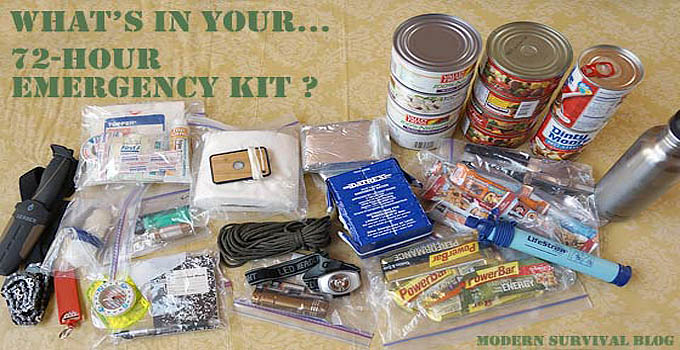72-Hour Emergency Kit

EVERYONE should keep a 72-hour emergency survival kit in their vehicle. No excuses.
Why? Because if you unexpectedly have to evacuate or get away for any reason, or if you are unable to return home, your 72-hour emergency kit will provide you with the essentials that you might need to survive for up to 3 days.
UPDATED:
WHEN You Might Need A 72-hour Emergency Kit
– Hurricane warning and you must or should evacuate.
– Forest fire is threatening your neighborhood.
– Earthquake damage in your region prohibiting you from returning home.
– Winter snow or ice-storm has stranded you away from home.
– Tornado has destroyed your neighborhood and all you have is in your car.
– Vehicle breakdown while traveling in remote location.
– Accident sends you over embankment where no-one see’s you – you’re trapped.
– You’re out camping, hunting, fishing and simply need more food-water.
– Tsunami warning has been issued near you.
– Sudden evacuation order because an upstream dam is failing.
– Nuclear accident, detonation, or dirty-bomb in your region.
– Martial law is declared and you’re bugging out to your survival retreat.
– Grid down in your city and you’re bugging out.
– The economic collapse has come and you’re escaping the looting and rioting.
– SHTF scenario (pick any…)
WHAT Food Should I Store In My 72-hour Emergency Kit?
There are many opinions and recommendations for what to keep in a 72-hour emergency kit. In fact, many who do have such a kit will often readjust it from time to time for the season or changing circumstances.
The basic goal is to simply keep enough categorical supplies for food, water, fire, shelter, medical, first-aid, security, tools, clothes, pets — to cover a 3-day period.
How much water?
It’s a good idea to store (at least) about 1.5 gallons of water per person to cover a 3-day period, which is about 12 typical size water bottles.
Note: A good portable drinking water filter is highly advised in case you don’t have enough water or run out. A good choice: Sawyer Mini Water Filter
How much food?
Store approximately 6,000 calories (3-days) of food for each person who would most likely be traveling in the vehicle.
What kind of food?
Ideally you want foods that are calorie dense to save space, especially if you find yourself having to walk with a backpack.
Choose a variety of foods that do not require cooking, or those already cooked (canned).
Food list ideas…
Emergency Food Bars – ~200 calories, depending on choice
Datrex 3600 calorie pack, Emergency Food Bar
Chocolate bars, hard candy (quick energy) – 200 calories
Canned beef stew – 400 calories
Canned meat (Turkey, Chicken, Beef Brisket) – 400 calories
Premium Chunk Chicken Breast, 6 Count
Peanut Butter – 3,000 calories in a typical jar!
Beef Jerky snacks – 70 calories
MRE’s – ~400 calories, depends on MRE
MRE’s by the Case
Granola type trail mix
Nuts (they’re high in calories)
Snacks that are salt-free or low-salt (minimize thirst)
Note: You can eat most canned foods ‘cold’ (commercially processed)
Note: Have a small can opener or pull-tab cans
Where to store the food?
For the vehicle, consider keeping your foods in an appropriate size ‘cooler’, which will help keep the internal temperature more stable (keeps out the extreme heat or cold). My truck’s rear seats lift up exposing storage spaces where I keep my foods (it’s cooler under there during the summer).
Note: Rotate out your food after each summer due to probable exposure to excessive temperature extremes which reduces food shelf life. Simply work the rotated food into upcoming meal plans and eat it (so you don’t wast it).
OTHER Items For 72-hour Emergency Kit
A list of additional non-food items to be included with your 72-hour kit could become a long one. The challenge is to consider each item’s ‘need’ or usefulness along with it’s weight and space requirement. Bear in mind that you might be traveling on foot, and bear in mind that this kit is designed to get you from point-A to point-B over an approximate 72-hour period (as opposed to a longer term bug-out kit, etc..).
Categories:
Think about the following non-food item categories and build your kit:
Combustion (fire making)
Cutting (knife)
Cordage (paracord/rope)
Cover (shelter)
Container (boiling water/cooking/etc..)
Shelter (tarp/tent/etc..)
Medical
First-aid
Security
Tools
Clothes
Pets
Some specific non-food item ideas in no particular order…
First Aid Kit Coleman First Aid Tin
Toilet Paper
Blanket and/or sleeping bag
Backpack
Cord, paracord, 550 Paracord, 7 Strand
Rain gear, Poncho
Seasonal jacket, hat, gloves
Sneakers / walking shoes / hiking boots
Extra socks, change of underwear, long-sleeve shirt
Knife (two is one, one is none)
Spoon for civilized eating ;)
Can Opener for canned food
Stainless Steel Canteen w/cup, Military Canteen with Cup
Water purification tablets
Water filter
Detailed Maps of the region you may travel, and a compass
Road Atlas for each state you may travel
Flashlight, headlamp, and batteries
Lightstick (bend-and-shake)
Portable radio, pocket radio
Handheld 2-way radios
Lighter, matches, firestarter, tinder
Candle
Whistle
Mylar foil ’emergency blanket’
Notepad and pen in Ziploc bag
A Plan – phone numbers, pre-planned destination options
Prescription meds if applicable
Pain relievers
Work gloves
Small portable camp stove, Ultralight Portable Camping Stove
Leatherman tool
Pet food
Pet water bowl
Leash / collar
Tailor your 72-hour kit to your own needs, your own region of travel, your own requirements.
I cannot overemphasize enough – to have a plan AHEAD OF TIME. Decide on evacuation routes and several optional destinations. Write down their address and phone numbers on paper (keep in kit). Know how to get there without GPS! Make reservations immediately (if applicable). If you’re heading to Uncle Joe’s rural farm, let him know, and be sure that you would be welcomed there ;)
